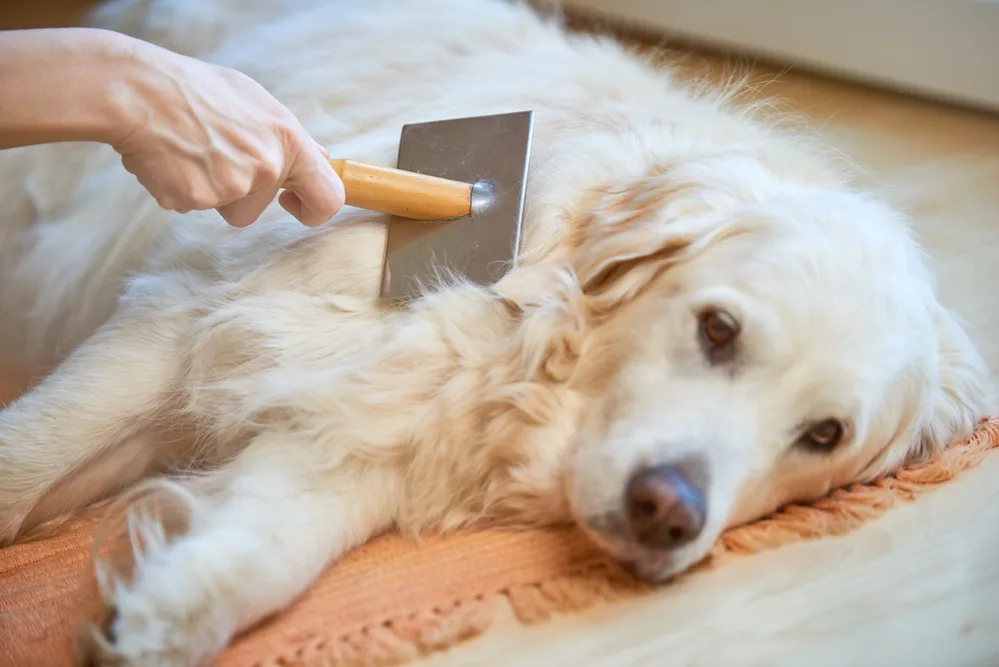Is there anything cuter than a soft puppy?
Dog fur comes in all styles and colors, from long, silky strands to short hairs.
However, you might have noticed dog hair lying around your home.
We call hair loss in dogs “shedding.” It can take some owners by surprise.
Why does my dog shed so much?
Dogs shed for various reasons. It’s usually normal but can also point to health problems. Skin conditions, poor diet, and environmental factors could make your pup lose hair faster.
If your puppy loses hair in alarming amounts, don’t panic! Here are some reasons your dog is shedding and some quick tips to fix it.
Is Shedding Normal?
When I first got my dog, I couldn’t believe how much fur she had lost in one week! I felt like I was vacuuming mountains of dog hair every other day. There’s no way this could be normal, I thought to myself.
I quickly learned that shedding in dogs is very common. It’s a natural occurrence that even happens in humans!
Dogs shed to make room for new, healthy hair. It’s a necessary process that keeps their coat fresh and shiny.
However, large amounts of hair loss could point to a problem. Something else could happen if you notice extreme shedding with weird behaviors.
For example, your dog rubbing his face on you while losing fur could point to an underlying problem.
4 Reasons Why Your Dog Is Shedding

You’ll need to figure out why your dog sheds before you can fix the problem. The solution will ultimately depend on the cause. Keep these factors in mind before changing your dog’s lifestyle.
It’s Normal For Your Dog’s Breed
Your furry friend’s shedding might not be a problem! Some breeds experience higher rates of natural hair loss than others.
Shedding is widespread in double-coated dogs. Losing their undercoats is essential to their overall health.
Huskies, labs, and border collies have beautiful double coats. You can expect a bit of fur on your furniture if you own one of these breeds.
There’s an Environmental Trigger
Your dog doesn’t shed to annoy you; they do it for a purpose! Usually, average hair loss is in response to an environmental trigger.
Animals have defense mechanisms that are beyond their control. When temperatures get hot, they shed to keep themselves cool.
Your dog can’t wear a cute jacket when the season changes, as you can! They’ll also shed old hair to make room for a denser coat for winter.
They Have a Skin Condition
Unfortunately, not all hair loss is average. Your dog could be struggling with a skin condition.
You’ll know it’s unnatural shedding if your dog bites himself or exhibits other strange behaviors. Excessive stretching, rolling around, and rubbing against things could mean they’re itchy!
Allergies
Some dogs have allergies, just like people do. Allergies in dogs are pretty standard.
Sometimes, it’s something in their environment. Your pup could be allergic to grass, pollen, or laundry detergent.
They may also have a food allergy causing hair loss. Some grains and proteins could make your dog itchy and lead to excessive shedding.
Infections
Your four-legged friend might also have a skin infection. Bacterial and fungal infections often cause very noticeable hair loss.
For example, ringworm in dogs causes them to lose patches of hair in “ring-like” shapes. This parasite is common in pets that go to dog parks and doggy daycares.
Dermatitis can also lead to infections. Germs enter your dog’s body through scratches when they break their skin. Some itching is normal, but too much can cause gross infections that leave your pet uncomfortable.
They Have A Health Problem
Finally, your dog may have an underlying health issue causing extreme shedding. Cushing’s Disease in dogs is a hormonal imbalance with many scary symptoms, including hair loss.
That’s not the only illness that could affect your dog’s coat. Diabetes, kidney, and liver diseases often cause hair to fall out.
If your dog takes medication, check its common symptoms. Some medicines throw their systems out of whack, leading to excessive shedding.
How To Reduce Shedding In Dogs
Many owners struggle to accept hair messes, whether the shedding is natural or due to a problem. Just look at this data The New York Post collected about dog hair. Out of 2,000 pet owners:
| People finding hair in their food: | 27% |
| People finding hair on their toothbrushes: | 10% |
| People embarrassed by shedding: | 15% |
| People who accept dog hair in the home: | 60% |
| People who would consider rehoming their dog over the issue: | 30% |
| Average time people spend cleaning up excess dog hair: | 2 hours and 18 minutes |

Put away the vacuum catalogs and take our advice. If you’re part of a group that finds shedding embarrassing, here are some tips to ease your frustrations.
Brush Them More Often
You can’t always control how much hair your dog loses. However, brushing them more often can prevent when and where they shed.
Brushing removes dead hair, so it doesn’t fall all over your home. It’s also not just an activity for long-haired pups.
Your short-haired dog also needs regular brushing. Use a rubber brush to get rid of their shedding coat. If you start early, you can train your dog to enjoy the process.
Use De-Shedding Tools
Sometimes, you need more than a brush to finish the job. Fortunately, owners have access to so many great de-shedding tools.
Undercoat brushes and rakes have a unique design to de-shed thick-coated dogs. Be careful when using these tools; some have sharp edges, so handle them carefully.
You can also invest in special de-shedding shampoo and conditioner. Make sure your bathtime supplies are dog-friendly since human-grade soaps can cause intense skin problems.
Take Them to a Groomer
If doing your dog’s hair sounds like a chore, take them to a professional. Groomers have all the right supplies to transform your dog’s shedding coat.
You need expert assistance if your dog stinks after a bath and loses his hair. Some groomers even offer at-home services, so your pup can have a spa day while you relax on the couch!
Of course, using a groomer isn’t always an option. Watch this video to learn how to bathe your dog at home!
Change Their Diet
Nutrition plays a massive role in coat quality. If you want to nip your dog’s shedding problem in the bud, consider changing their diet.
Pet food brands like Purina and Hill’s Science Diet make food for sensitive skin. This diet gives your dog the right balance to keep its fur intact.
Changing their diet is vital if your dog has a food allergy. You might have to do an elimination test to figure out what’s causing the problem.
Talk To Your Veterinarian
You should always talk to your veterinarian before altering your dog’s routine. They can offer valuable insight that could improve your shedding issue.
Your vet can find a cure if the hair loss is due to a medical problem. They can switch to a better substance if they react to medications.
Vets also have access to prescription shampoos, kibbles, and treats that can help with excessive shedding. You wouldn’t make a significant lifestyle change without consulting your doctor, so why should your dog be different?
FAQS
What month do dogs shed the most?
Most dogs shed during the spring and fall to prepare for the weather. Expect dead hair from March-May and September-November. Remember that all dogs are different and may shed on an altered schedule.
Can dog food help with shedding?
Absolutely! Feeding your dog a well-balanced diet can help them retain their fur. Feed your pup high-quality dog food with a particular focus on hair and skin. Some brands we like include Hill’s, Royal Canin, and Purina.
Does stress increase shedding?
Stress often causes extreme hair loss in both humans and animals. Increased hormone levels can throw your dog’s system for a loop. Find out what’s causing the anxiety and address the problem ASAP.
What is the normal amount of shedding?
“Normal shedding” is different for every breed. However, your dog shouldn’t shed so much that they have bald spots. If you can see patches of skin, your furry friend is having a problem.
The Bottom Line
Gone are the days of hairy clothes and dirty couches. Now that you know why your dog sheds so much, you can start de-shedding your life!
All dog owners must accept that shedding is normal. That doesn’t mean you should deal with hairy food for the rest of your life!
If you have a shedding breed, upgrading their grooming routine will help. Get yourself some brushes and de-shedding shampoo for your next spa day.
You could even enlist the help of a professional. Groomers do wonders with hair clippers and a bathtub.
Sometimes, all your pup needs is a change in diet. However, you should always consult a veterinarian to check for underlying health problems first.
So, grab your furry friend and start snuggling! You’ll never have to worry about hairy messes with our expert advice.
